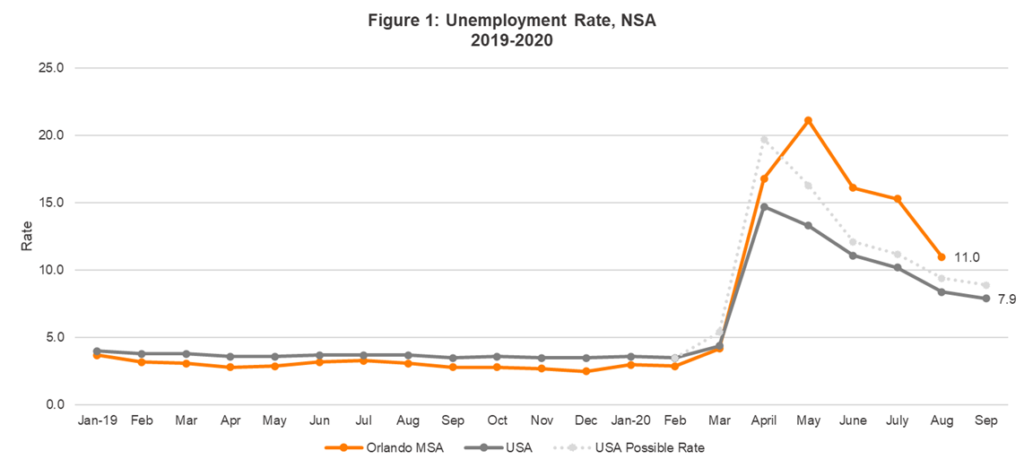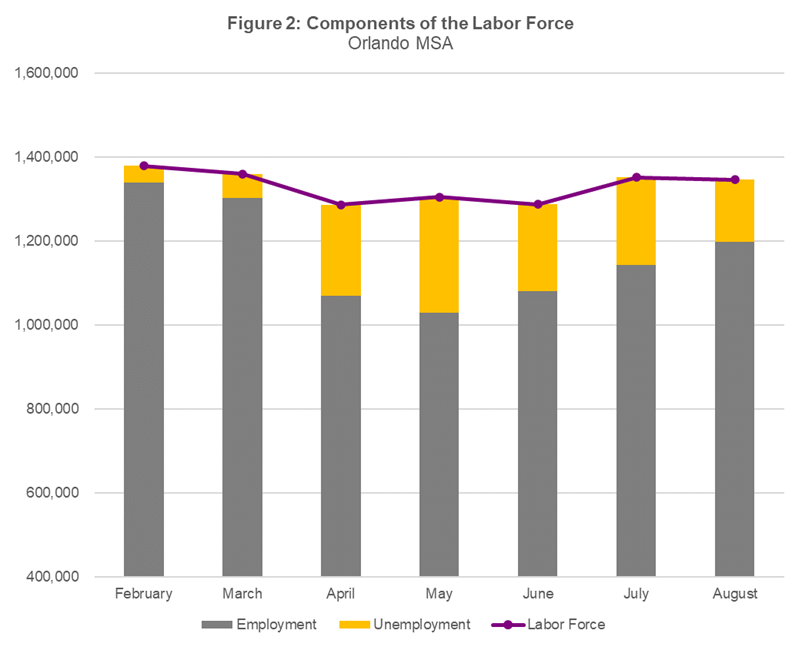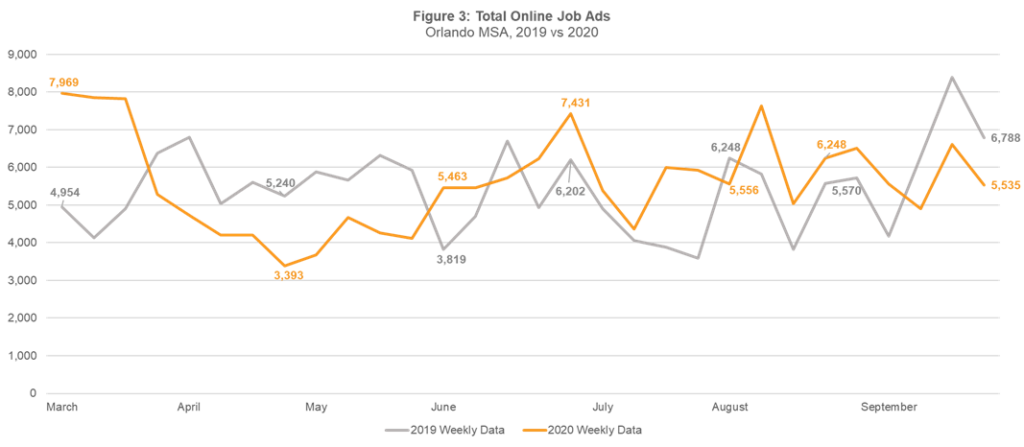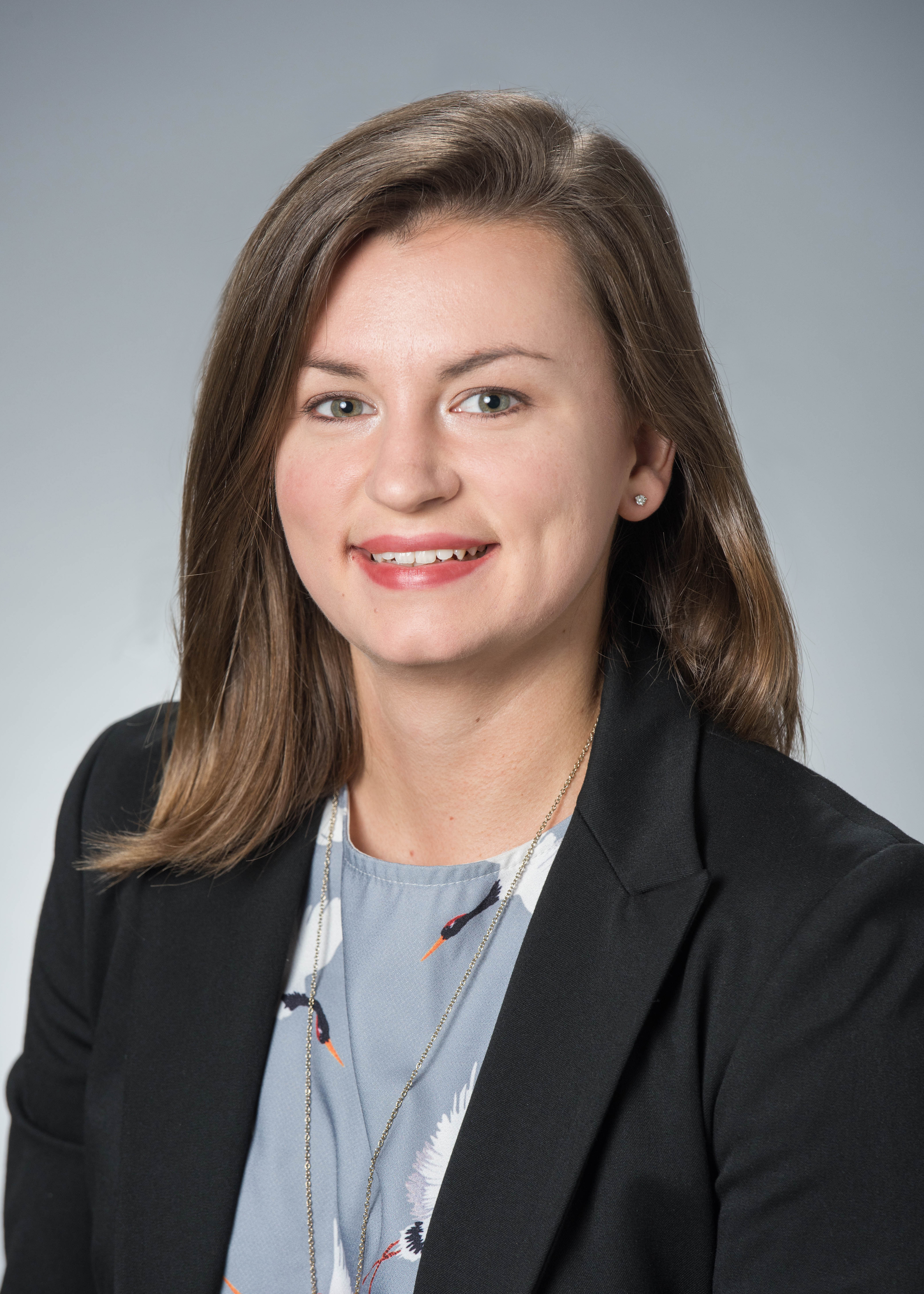This third quarter 2020 economic update explores the conflicting dynamic between the number of permanently unemployed individuals and business’ struggle to find skilled workers to fill open positions.
An emerging dichotomy is beginning to play out in the country’s job market. The number of permanently unemployed individuals in the U.S. is rising and a total of 12.6 million people are currently out of work across the nation. At the same time, industries across the country in several states, ranging from Indiana to Maryland to Florida and beyond, are struggling to find skilled workers to fill open positions. This doesn’t mesh.
This doesn’t mesh.
Conventional economic wisdom suggests that it would be harder to find skilled workers in a tight labor market with under three percent unemployment, which the country had been experiencing prior to the COVID-19 outbreak in the United States. That’s not the case now with an unemployment rate of almost eight percent. These trends are broken down below for both the nation and Orlando.
An Increasing Number of Permanently Unemployed Individuals
The U.S. Employment Situation Report for September was released on October 2 and rounded out the national employment summary for quarter three. Overall, the national unemployment rate continued to drop, falling 0.5 percentage points over the month to 7.9 percent. The number of unemployed persons fell by 1 million to 12.6 million (see figure 1 below). The most recent unemployment rate data for Orlando shows the combined Orlando metro (Lake, Orange, Osceola, and Seminole County) unemployment rate to be 11 percent.

This is a positive trend as the unemployment rate continues to fall from national highs of 14.7 percent in April and Orlando highs of 21.1 percent in May. However, the number of permanent job losers increased this past month by 345,000 to 3.8 million nationally. This has been an increase of 2.5 million since February and is a metric to watch even as unemployment rates fall, as it signals more permanent impacts to the economy that will be harder to bounce back from in the next several months.. A slightly different metric also worthy of watching is the number of long-term unemployed individuals (those jobless for 27 weeks or more), which increased by 781,000 to 2.4 million in the month of September.
While the number of permanent job losers is not available at the regional level, drops in the regional labor force do provide some sense that Orlando is also experiencing more permanent economic shocks. Those who fall out of the labor force are not included in the unemployment rate calculation and act as a signal that workers are quitting the job hunt altogether. (For a discussion on how the unemployment rate and labor force participation rate differ, see the footnote below.[1]) The Orlando metro labor force fell by roughly 5,800 individuals from July to August and is 2.4 percent smaller than it was in February. See Figure 2 below.

A Need for Talent
At the same time as the number of permanently unemployed people across the country is increasing, job posting activity and the need for skilled workers is also increasing. Job posting activity in the Orlando MSA plummeted in early April but has since come back strong as HR professionals became accustomed to remote work and onboarding. For most of Q3, 2020, job posting activity has averaged at 6,000 posts per week in Orlando and individual weekly activity has outpaced posting from this same time in 2019. See Figure 3 below.

Recent observations from Hiregy, an Orlando, Tampa, and St. Petersburg staffing agency report that “July, August and September have been extremely busy as there has been a major backlog of hiring needs from when things were on hold back in March and April.”
Analysis of data from Burning Glass Technology’s Labor Insight tool show that the hard to fill occupations in Orlando, with the highest demand over the last six months, range in position from registered nurses to security guards to janitors to software developers. The 22 roles with very high demand in Orlando over the last six months take an average of 31 days to fill and have a salary range of anywhere from $21,000 to $114,000. Yet some of these “hard to fill positions” have unemployment rates of at least 10 percent. Food preparation workers and laborers moving stock by hand have unemployment rates of 32 and 25 percent. See Table 1 below.
Table 1: Orlando’s Most In-demand Positions
(6 Months Previous to October 2020)
| Job Title (SOC) | Number of Job Posts | Time to Fills (Days) | BLS/OES Salary | Unemploy-ment Rate (July 2020) |
| Combined Food Preparation and Serving Workers, Including Fast Food | 1,731 | 33 | $21,080 | 32.0% |
| Laborers and Freight, Stock, and Material Movers, Hand | 1,871 | 32 | $30,140 | 25.0% |
| Retail Salespersons | 4,100 | 30 | $27,260 | 14.0% |
| Customer Service Representatives | 3,473 | 27 | $33,840 | 13.0% |
| Janitors and Cleaners, Except Maids and Housekeeping Cleaners | 1,440 | 32 | $24,480 | 12.0% |
| Nursing Assistants | 1,203 | 30 | $27,420 | 12.0% |
| Secretaries and Administrative Assistants, Except Legal, Medical, and Executive | 1,643 | 29 | $35,470 | 11.0% |
| Maintenance and Repair Workers, General | 2,198 | 32 | $35,580 | 10.0% |
| Medical Secretaries | 1,200 | 25 | $32,800 | 10.0% |
| First-Line Supervisors of Retail Sales Workers | 2,564 | 33 | $46,140 | 9.0% |
| Security Guards | 1,685 | 31 | $26,620 | 8.0% |
| Medical Assistants | 1,398 | 34 | $33,310 | 8.0% |
| Sales Managers | 1,380 | 31 | $114,030 | 7.0% |
| General and Operations Managers | 1,214 | 25 | $101,310 | 7.0% |
| Sales Representatives, Wholesale and Manufacturing, Except Technical and Scientific Products | 4,910 | 31 | $60,840 | 6.0% |
| Insurance Sales Agents | 1,327 | 34 | $59,800 | 6.0% |
| Food Service Managers | 1,307 | 30 | $57,570 | 6.0% |
| Registered Nurses | 6,143 | 30 | $64,990 | 4.0% |
| Software Developers, Applications | 2,626 | 34 | $102,390 | 4.0% |
| Medical and Health Service Managers | 1,673 | 27 | N/A | 4.0% |
| Managers, All Other | 2,240 | 34 | $105,730 | N/A |
| Critical Care Nurses | 1,372 | 37 | $64,990 | N/A |
A Labor Market Dichotomy
So, what is causing this mismatch? How can there be both consistent, high demand for specific positions while existing workers in that occupation are experiencing high levels of unemployment? The Indicator Podcast from NPR struggled with this same question in their October 2 episode, Job Friday: The Worker Shortage Mystery. The key takeaway: there is no worker shortage, with “eight million more unemployed people than there are job openings” currently in the country. Instead Heidi Shierholz, Senior Economist and Director of Policy at the Economic Policy Institute, argues that the country has just undergone a massive economic shock and, in those cases, the labor market dynamics of supply and demand for talent simply “meltdown” for a period until the system can align itself again.
Annelies Goger and Luther Jackson grappled with this issue as well in a recent piece for the Brookings Institute, arguing that the economy does not have a skills gap or a worker shortage. Instead there is an opportunity gap, where a lack of access to the proper networks, equitable hiring practices, affordable education and on-the-job learning contribute to an opportunity gap, leaving potentially talented workers out of the candidate pool.
As Orlando moves into the final months of 2020, these two colliding trends will be ones to watch. As more temporary job losers return to work and more permanent impacts from the pandemic reveal themselves, closing the gap between individuals looking for meaningful work and companies seeking the right talent will be imperative to Orlando’s full economic recovery.
Other Items of Note that Happened in Q3 2020
- Disney reopened Orlando parks at reduced capacity to visitors on July 11 and July 15, but announced layoffs of 28,000 employees in late September citing the heavy impacts of COVID-19 on their business.
- The Orlando Film Commission saw a rise in productions post COVID-19, bringing valuable economic impact to the region, including national commercials, independent feature films and episodic TV series. New updates on Orlando-based film projects include David Makes Man, now available to view on HBO Max, confirmed a second season to be filmed in Orlando, The One and Only Ivan is now available to stream on Disney+, and Magic of Disney’s Animal Kingdom will premiered September 25. The Right Stuff will have a two-episode premiere on October 9, both also on Disney+.
- The Amway Center announced that it will be the site of an early voting location for the 2020 general election, serving a greater portion of the community West of I4.
- SIMCOM International, Inc. announced the expansion and building a new worldwide headquarters in Orlando. The provider of pilot and maintenance training to customers in over 80 countries, the company is investing $109 million in the new headquarters and training facility, with plans to create more than 50 new high wage jobs over the next two years.
Footnote
[1] Important Definitions: The labor force is made up of both employed and unemployed individuals. The unemployment rate is the percentage of the labor force counted as unemployed. To be counted as unemployed, a person would need to both: not have a job and have made some effort to find a job in the previous four weeks. This definition means that individuals who stop looking for work after a month are removed from the labor force and not counted in the unemployment rate. The labor force participation rate however, measures those who are counted in the labor force, either employed or unemployed, as a percent of the total, eligible working-age population. Read more about how these measures are calculated here.

